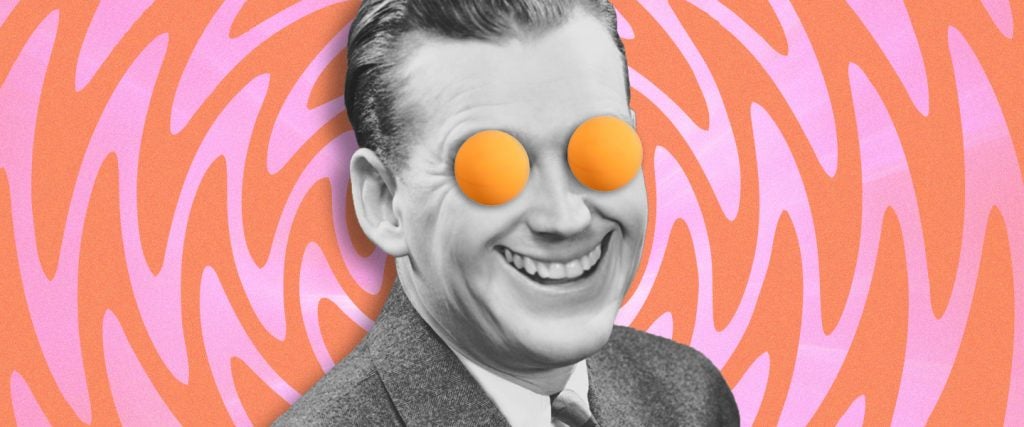If you’re trying to cut back on weed or booze, the concept of a natural high is understandably appealing. But the things that are often suggested — like food, sex or exercise to amp up your dopamine — are usually something you’re already well aware of. In my recent search for a new natural high, however, I stumbled on a Reddit post that described an experience I definitely had never heard of before — and it starts with sawing a ping-pong ball in half.
Here’s how the redditor says it works: You use the ping-pong ball halves as makeshift goggles to block out light for a sensory deprivation experience, further enhanced by turning off any lights in the room and listening to static noise through headphones for several minutes. At some point, you should start to hallucinate and possibly feel “a sense of extreme and imminent danger” and “gain a spike in adrenaline. Continue as long as needed or until insane.”
Surprisingly, what the redditor is describing is actually a very sane and scientifically-backed phenomenon known as the “Ganzfeld effect.” First described by psychologist Wolfgang Metzger in 1930, the Ganzfeld effect describes a short-term altered state of consciousness that’s the result of depriving multiple senses at once. It’s been demonstrated in several studies, as well as on YouTube and TikTok. There are even “Ganzfeld goggles” that you can buy or make with household items that aren’t necessarily related to table tennis, like cotton balls, paper and string.
A recent study published in the journal Scientific Reports monitored the brain activity of 19 individuals using fMRI scans while they used ping-pong balls, white noise and LED lights with warm colors and white noise to try to achieve the effect. Hallucinations related to psychedelic use or psychosis from mental disorders is typically linked with a malfunctioning thalamus in the brain, or what scientists describe as increased “thalamo-cortical coupling,” a type of sensory overload. Likewise, drug use and psychosis is associated with decreased activity in the default mode network of the brain, which is usually activated when we have no tasks to perform and our mind can wander. Interestingly, researchers found that in the case of hallucinations related to the Ganzfeld effect, the opposite was true. The thalamo-cortical coupling in participants decreased as the default network of their brain became more active. The researchers concluded that this creates a similar yet different neurological imbalance that “could explain why participants sometimes experience hallucinations.”
When I reached out to psychologist Raffaello Antonino, he assured me that “the Ganzfeld effect isn’t harmful, it’s simply a by-product of how our brains normally function.” Likewise, he confirmed that as much as the Ganzfeld effect can result in a temporarily altered state that may include hallucinations, it’s “entirely dissimilar to any drug experience in that it doesn’t require the presence of otherwise absent chemicals in our nervous system.”
Based on this, I had no reason not to spend $6.99 on a pack of 12 Franklin table tennis balls at Target just to cut one in half with a crappy kitchen knife. It’s recommended that a person sit for anywhere from five to 30 minutes in order to achieve the full effect, but I went with the same amount of time the study subjects did: 25 minutes. Since I live in a noisy, creaky Chicago apartment, I doubled up on white noise, with a machine I use to sleep, as well as through my headphones. Then I proceeded to lay in the dark.
About seven minutes in, my dog jumped on me, startling me out of a meditative state. That said, I laughed the way that high people do when nothing is particularly funny, so I knew I was feeling something.
After satiating my pup with some treats, I attempted the Ganzfeld effect again. For the first 10 or so minutes, I was mostly trying to not force myself to feel anything or experience what scientists described as a “pseudo-hallucination.” I felt my eyes moving rapidly back-and-forth, similar to what I imagine they do during REM sleep. At a certain point, the biggest challenge was not falling asleep.
Still, due to late-afternoon exhaustion, I’m pretty sure I drifted off at some point anyway. I heard some noises from my neighbors outside, and birds chirping, but it was unclear if those were hallucinations or reality. When my alarm went off at the 25-minute mark, I did a body scan and realized I could no longer feel my hands. I consciously was aware that I had them laying flat on my thighs, but it really felt like they were gone. So I didn’t lose my head, but I lost some part of my perception.
For the next 10 or so minutes of being awake, I didn’t feel high exactly, but I felt weird — a little lighter, loopier and sensitive to light and sound. It was similar to trying a drug, in that it elicited a smiley sense of “hey, this isn’t bad,” but it wasn’t that intense. Ultimately, the closest thing I could compare it to is the endorphin rush you get after a really intense round of exercise and post-workout meal.
But I definitely have the balls — and interest — to try it again.

